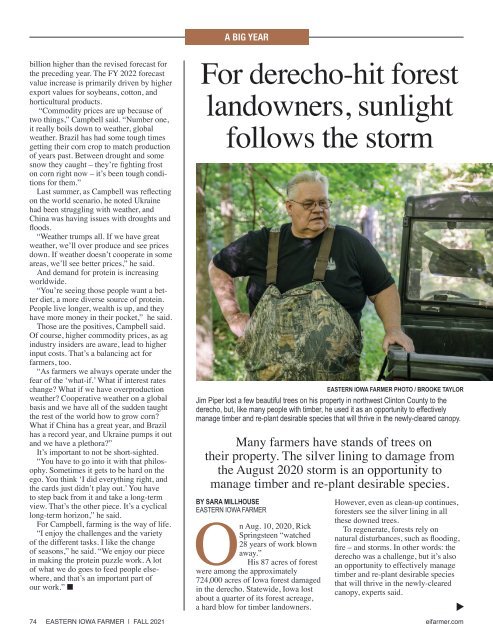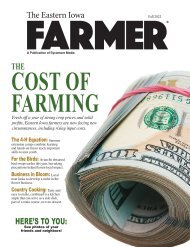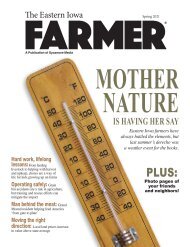Create successful ePaper yourself
Turn your PDF publications into a flip-book with our unique Google optimized e-Paper software.
a big year<br />
billion higher than the revised forecast for<br />
the preceding year. The FY 2022 forecast<br />
value increase is primarily driven by higher<br />
export values for soybeans, cotton, and<br />
horticultural products.<br />
“Commodity prices are up because of<br />
two things,” Campbell said. “Number one,<br />
it really boils down to weather, global<br />
weather. Brazil has had some tough times<br />
getting their corn crop to match production<br />
of years past. Between drought and some<br />
snow they caught – they’re fighting frost<br />
on corn right now – it’s been tough conditions<br />
for them.”<br />
Last summer, as Campbell was reflecting<br />
on the world scenario, he noted Ukraine<br />
had been struggling with weather, and<br />
China was having issues with droughts and<br />
floods.<br />
“Weather trumps all. If we have great<br />
weather, we’ll over produce and see prices<br />
down. If weather doesn’t cooperate in some<br />
areas, we’ll see better prices,” he said.<br />
And demand for protein is increasing<br />
worldwide.<br />
“You’re seeing those people want a better<br />
diet, a more diverse source of protein.<br />
People live longer, wealth is up, and they<br />
have more money in their pocket,” he said.<br />
Those are the positives, Campbell said.<br />
Of course, higher commodity prices, as ag<br />
industry insiders are aware, lead to higher<br />
input costs. That’s a balancing act for<br />
farmers, too.<br />
“As farmers we always operate under the<br />
fear of the ‘what-if.’ What if interest rates<br />
change? What if we have overproduction<br />
weather? Cooperative weather on a global<br />
basis and we have all of the sudden taught<br />
the rest of the world how to grow corn?<br />
What if China has a great year, and Brazil<br />
has a record year, and Ukraine pumps it out<br />
and we have a plethora?”<br />
It’s important to not be short-sighted.<br />
“You have to go into it with that philosophy.<br />
Sometimes it gets to be hard on the<br />
ego. You think ‘I did everything right, and<br />
the cards just didn’t play out.’ You have<br />
to step back from it and take a long-term<br />
view. That’s the other piece. It’s a cyclical<br />
long-term horizon,” he said.<br />
For Campbell, farming is the way of life.<br />
“I enjoy the challenges and the variety<br />
of the different tasks. I like the change<br />
of seasons,” he said. “We enjoy our piece<br />
in making the protein puzzle work. A lot<br />
of what we do goes to feed people elsewhere,<br />
and that’s an important part of<br />
our work.” n<br />
For derecho-hit forest<br />
landowners, sunlight<br />
follows the storm<br />
<strong>Eastern</strong> <strong>Iowa</strong> <strong>Farmer</strong> photo / Brooke Taylor<br />
Jim Piper lost a few beautiful trees on his property in northwest Clinton County to the<br />
derecho, but, like many people with timber, he used it as an opportunity to effectively<br />
manage timber and re-plant desirable species that will thrive in the newly-cleared canopy.<br />
Many farmers have stands of trees on<br />
their property. The silver lining to damage from<br />
the August 2020 storm is an opportunity to<br />
manage timber and re-plant desirable species.<br />
BY Sara Millhouse<br />
eastern iowa farmer<br />
On Aug. 10, 2020, Rick<br />
Springsteen “watched<br />
28 years of work blown<br />
away.”<br />
His 87 acres of forest<br />
were among the approximately<br />
724,000 acres of <strong>Iowa</strong> forest damaged<br />
in the derecho. Statewide, <strong>Iowa</strong> lost<br />
about a quarter of its forest acreage,<br />
a hard blow for timber landowners.<br />
However, even as clean-up continues,<br />
foresters see the silver lining in all<br />
these downed trees.<br />
To regenerate, forests rely on<br />
natural disturbances, such as flooding,<br />
fire – and storms. In other words: the<br />
derecho was a challenge, but it’s also<br />
an opportunity to effectively manage<br />
timber and re-plant desirable species<br />
that will thrive in the newly-cleared<br />
canopy, experts said.<br />
74 <strong>Eastern</strong> <strong>Iowa</strong> <strong>Farmer</strong> | <strong>Fall</strong> <strong>2021</strong> eifarmer.com<br />
<strong>Eastern</strong><strong>Iowa</strong><strong>Farmer</strong>_<strong>Fall</strong><strong>2021</strong>.indd 74<br />
9/15/21 10:25 am
















